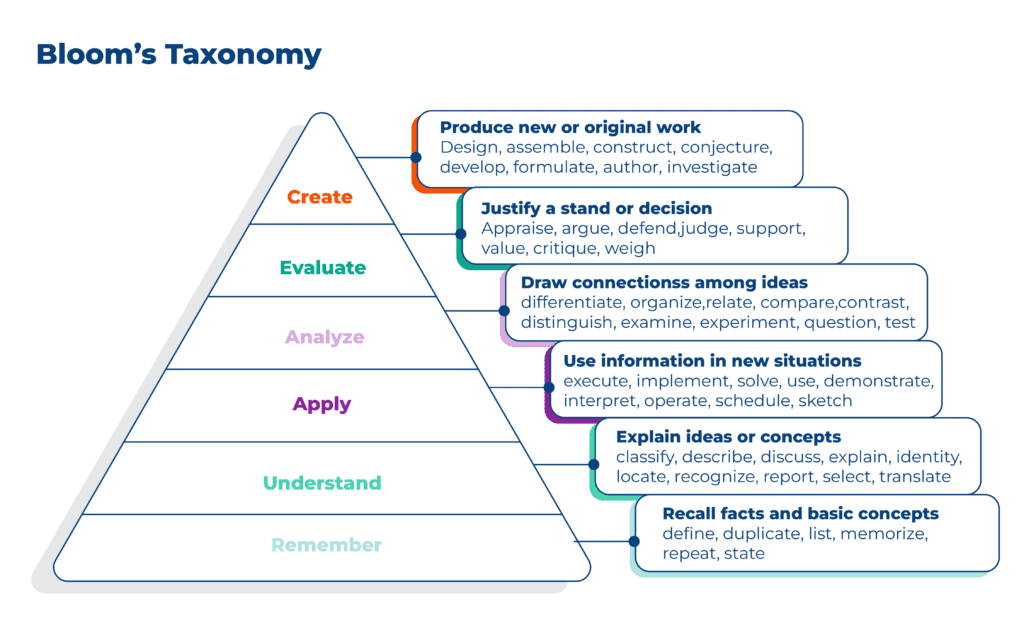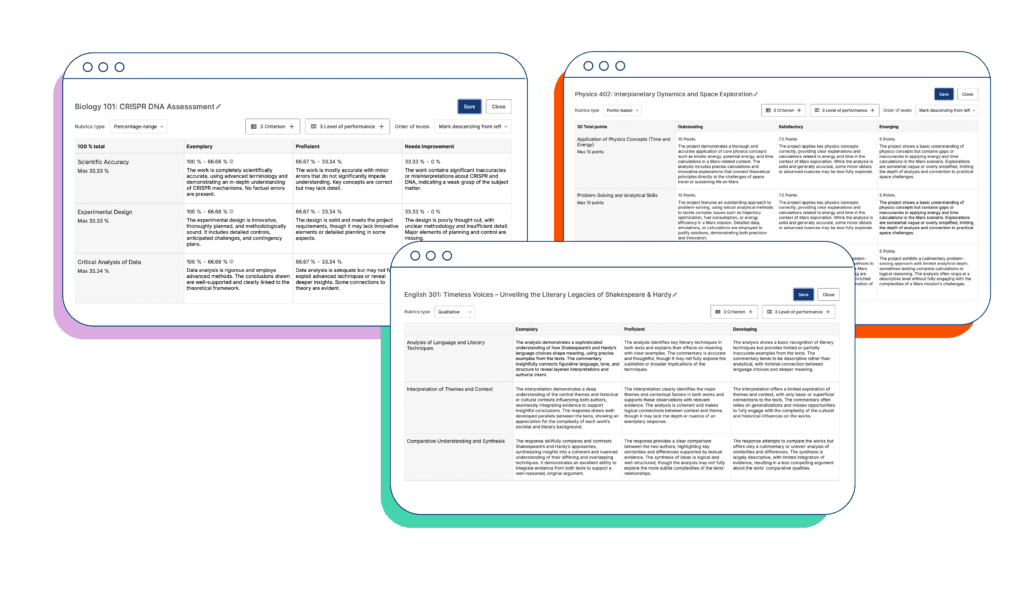
Rubrics are an integral element of modern education, and while there is a strong consensus on their value, the complexity lies in their varied application.
As rubrics evolve with the demands of education, they must shift their focus from being mere knowledge checks to acting as comprehensive feedback mechanisms designed to engage learners in their own journey. This transformation promotes meaningful feedback, supports increased student improvement, and fosters consistency in assessments, with the added benefit of enhancing grading efficiency for educators. While some institutions have achieved this, others have struggled.
At Inspera, we understand the importance, and value of rubrics in a learners journey, and have developed advanced features and capabilities to support this building block. Rubrics bring equity in assessment by ensuring all students are evaluated according to the same standards, regardless of their background or prior educational experiences.
In this post, we’ll revisit our shared understanding of rubrics and explore their pivotal role in higher education, as well as the opportunities and challenges that arise with their application.
A Quick Note Before Reading
For the purposes of this blog post and for clarity, we have used the terms ‘assessment’ and ‘assessments’ to differentiate two interpretations of the word:.
Assessment relates to the process of analyzing the understanding and mastery of a topic as well as progress made.
Assessments refer to the tools used for assessment: exams, papers, projects etc.
What Is a Rubric: Main Types and Elements
In most higher education institutions, rubrics are a familiar and well-established practice, particularly among teaching and learning specialists and academics. While they are well understood, it’s important to revisit the foundational aspects to ensure we’re aligned with a shared understanding.
At its core, a rubric is a scoring guide used to evaluate the performance of students in various assignments, including group projects, portfolios, research papers, and presentations. It consists of a set of criteria and standards linked to learning objectives that are used to assess a student’s performance. Their aim is to provide clarity of expectations for the student, streamline the workflow and grading process for teachers, and enhance teaching and learning through consistent grading and detailed feedback.
The history of rubrics, while difficult to trace to a single origin, finds its theoretical roots in the work of Benjamin Bloom and his colleagues, particularly in their development of the Taxonomies of Educational Objectives in the 1950s. Bloom’s taxonomy aimed to categorize cognitive skills and learning outcomes, creating a framework teachers could use to structure educational goals and assess them systematically, ultimately becoming influential in guiding educational assessment practices.

Though Bloom’s taxonomy has long been foundational, it remains the subject of ongoing debate. Critics argue that the original model may fail to fully capture the complexity of cognitive skills in today’s learning environments, and as education evolves, so too do the expectations for rubrics to assess higher-order thinking and skills beyond what was initially conceived in Bloom’s work.
To this end as pedagogy has shifted over time, in response to the evolving demands of education, rubrics have evolved from basic grading tools into dynamic supports for student centered learning, adapting to the rise of technology, competency-based education, and inclusive practices. Modern rubrics now assess a wider range of skills, offer personalized feedback, and improve grading consistency through detailed criteria, reflecting these broader shifts in pedagogy (Brookhart, 2013, Reddy & Andrade, 2010, Jonsson & Svingby, 2007).
Despite this, they are still not without their limitations, and as the complexity of learning objectives increases, rubrics now need to evaluate more sophisticated skills such as critical thinking, analysis, and creativity, as well as an increased variety of assessment types. Therefore, it is through their effective application that we see their true value.
Modern rubrics must continue to adapt and be customized to measure these more advanced skills and changing assessment environments to overcome criticisms and common shortfalls, which we will explore within this article.
The Elements of a Rubric
On a general level there are, as defined by Popham (1997) in his seminal article on rubrics, three essential features that a rubric must have:
- evaluative criteria
- quality definitions
- a scoring strategy
However, it’s important to recognize that application differs across sectors, like K-12, higher education and awarding bodies. It’s also crucial to note that rubrics must go beyond the basic level information provided by institutions and seek to align with the broader pedagogical shift towards standards-based education, focusing on mastery of knowledge and skills rather than traditional grades or ranking systems.
Whilst this focus on mastery of knowledge is required across all institutions for all learners, it is particularly important in the wave of “non-traditional” also known as “new-traditional” learners that we see in the US, encompassing adult learners, first generation scholars and those returning to education.
For such learners, rubrics serve as both a grading tool and a communication device. Clear, detailed frameworks help educators explain expectations in a way that supports mastery learning. They offer transparency in what is required to succeed, which is essential for students who may not be familiar with academic norms or who are balancing education with other responsibilities. In turn, providing equity to all students.
The Types of Rubrics
As discussed, rubrics are familiar and well-understood tools for educators and academics, with the two most common types being Analytic and Holistic, with Scoring Guides and Single Point rubrics being lesser known. Here, we will explore each type of rubric, their use cases, and how they differ from one another.

Analytic rubrics evaluate a student’s performance on an assignment by breaking the assignment down into specific criteria and individually assessing each element.
For example, in a writing assignment, an analytic rubric might evaluate:
- Content: How well the student addressed the topic or answered the question.
- Organization: The structure and flow of ideas.
- Grammar and Mechanics: Spelling, punctuation, and grammar usage.
- Creativity: The originality and engagement of the writing.
An analytic rubric resembles a table, grid-style layout within which the assessment’s criteria are listed in the left side column with levels of performance listed across the top, using numbers and descriptive tags.
The rest of the cells within the rubric will either be left blank or contain further detail on what the specified criteria entails for each performance level. When using an analytic rubric, each criteria is assessed individually.
Analytic rubrics are thought to work well for complex assignments as they provide teachers the opportunity to leave comprehensive and deeper, more meaningful feedback on strengths and weaknesses so that the criterion can be weighted to reflect the relative importance of each dimension, showing the student exactly where there is room for improvement or detailing excellent performance.
As explored by South Western University, a Holistic Rubric, per its name, provides students with a general overview of their work as a whole rather than individual components, as is the case with presentations, capstone projects, or even portfolios. Students are given overall criteria of what is expected by describing the characteristics of a paper that would be an “A” or be marked excellent, a “B” or proficient, a “C” or average and so on.
The differentiating factor between holistic and analytic rubrics lies in the approach to scoring. A holistic rubric provides a single score based on an overall judgment of a candidate’s performance, making it quicker to use but less detailed. In contrast, an analytic rubric breaks down the performance into multiple criteria, with each criterion being scored individually.
Holistic rubrics may be more commonly used when there is no single correct answer, if the assignment is low stakes or skill or behavior based.
A scoring guide provides a set of criteria that describe various levels of achievement or quality, helping educators assign scores based on how well the student meets the expectations. Scoring guides often outline specific benchmarks for performance. Students are then awarded full or partial credit for mastering standards.
The difference between rubrics and a scoring guide is most evident in the ‘how’ they are used by the educator. For instance, scoring guides allow you to enter a number as the grade for a criterion, whereas traditional rubrics contain preset levels for each criterion that the educator can select from when reviewing the criterion.
Scoring guides may be more typically used for assessments that don’t require a granular breakdown of the criteria or are deemed to be “more open-ended” such as art projects, creative writing or open-ended discussions. In applying a scoring guide, students are still given a consistent mechanism for scoring and grading.
A single-point rubric outlines the criteria for success within assessments without specifying predefined levels of performance. Instead, it focuses on a single level of performance, which demonstrates proficiency. The single-point rubric allows room for students to exceed the criteria and further demonstrate their understanding of the assessed topic.
A single-point rubric may be utilized in cases where the educator would like to focus on a specific target while allowing room to provide students with quantitative, individualized feedback and promote individual growth and creative thinking.
While analytic, holistic, scoring guides and single-point rubrics each offer a baseline framework for evaluating student performance, their application across the higher education landscape is far from uniform.
The way rubrics are implemented varies widely across higher education, influenced by factors such as institutional goals, program requirements, and the diverse needs of students.
These variations introduce both challenges and opportunities for educators and learners, particularly when adapting rubrics to assess new-traditional learners or in courses that emphasize skills-based, project-based, or peer-reviewed learning.
In the next section, we’ll explore how these complexities shape the effective use of rubrics, their potential for enhancing assessments in higher education, and the challenges they pose.
Advantages and Disadvantages of Using Rubrics in Assessments
As we know, rubrics can be powerful tools for guiding fair and consistent assessments in higher education. They offer clear criteria to help ensure fairness and transparency in grading. Their structured approach enables educators to communicate expectations effectively, providing students with a roadmap to success.
Yet, despite these advantages, rubrics are not without their challenges. When overly rigid, they can limit creativity and fail to capture the complexity of more nuanced performances. Moreover, developing a well-designed rubric that is both comprehensive and adaptable can be time consuming. Thus, while rubrics present clear benefits, their effectiveness largely depends on faculty training, thoughtful implementation, and careful adaptation to the specific context.
Advantages of Rubrics

As pedagogy evolves, rubrics are changing and shaping assessment of work in the learning and educational environment, which has positive effects on both institutions and students. Their positive impact, however, is almost solely dependent on their effective application, which, while primarily the educator’s responsibility, is also partly reliant upon the student.
First, rubrics require a level of transparency and trust on the students’ part, namely their understanding of the approach, clarity around expectations and communication, and the opportunity for a robust learning experience. Second, a successful rubric is one in which students can reflect and critique their work to receive meaningful feedback.
When implemented effectively, rubrics can bring advantages such as:
- Legitimacy
- Affordability
- Accountability
- Increased student outcomes
- Improved instruction
- Path to evaluating programs
- Can be leveraged to meet wider institutional goals.
One of the key benefits of rubrics is their ability to provide legitimacy in assessment by offering a more reliable, and consistent approach, addressing concerns surrounding evaluator bias, lack of clarity around expectations, etc.
In the context of U.S. culture, starting in 1961 educators were pressured to assess writing ability with multiple-choice grammar tests. To be considered valid, writing assessments needed to be seen as “scientific,” which meant they had to appear standardized and objective. Since significant disagreements among evaluators were seen as unscientific, rubrics were developed to create a more consistent and acceptable method of judging writing. In essence, rubrics gave writing assessments the legitimacy it needed, as debated by Broad (2003).
Once established, rubrics can reduce the amount of time and effort required for grading, making assessments more efficient and, subsequently, more cost-effective for institutions. They streamline the workflow and reduce the administrative burden on professors.
Reducing the need for subjective or rhetorical judgment also means the task is suddenly done much quicker. As explored by (Jönsson & Svingby, 2007) this efficiency not only reduces the overall time spent on grading but also provides a reusable tool for future assessments.
However, the question of affordability needs to be placed in the wider ecosystem of processes in higher education and the varied designs across institutions. The affordability comes with having academic staff who can build course/program/institutional level outcomes into their rubrics in such a way that makes grading simpler and more time efficient while also checking all those administrative boxes.
Rubrics serve as essential tools in ensuring transparency and consistency in the assessments process, thereby enhancing accountability.
Mary J. Allen (2007) argues rubrics provide a standardized method for evaluating student learning outcomes, helping to ensure that students are assessed fairly and objectively. She continues emphasizing that rubrics can help institutions demonstrate they meet educational standards and provide student learning evidence to stakeholders. Barbara E. Walvoord (2010) echoes such arguments, highlighting rubrics as a way to document learning outcomes in a clear and organized way, further strengthening accountability.
While rubrics can enhance accountability by providing clear, consistent criteria for assessments, there are those who would argue they oversimplify assessment. Broad (2003) acknowledges that rubrics have historically played a key role in improving accountability by having a set of clear and simple terms for evaluation. Yet, he critiques the assessment of complex writing through rubrics, due to oversimplification and advocates for more nuanced approaches.
In recognition of such arguments, it’s clear that while rubrics can enhance accountability in assessments by providing transparent and consistent feedback, their design and implementation must be considered. Well-constructed rubrics must strike a balance between clarity and depth, meeting accountability standards without sacrificing the nuanced evaluation of student learning.
Rubrics can help to support common interpretations of student performance. In their meta-analysis, Ernesto Panadero. et al., (2023) assess the effects of rubrics on academic performance, self-regulated learning, and self-efficacy. They conclude that rubrics have a moderate positive effect on academic performance and a small positive effect on self-regulated learning and self-efficacy. Additionally, as found by Reddy and Andrade:
”Rubrics make expectations and criteria explicit, which also facilitates feedback and self-assessment.”
This clarity in expectations not only helps instructors provide more meaningful feedback but also empowers students to take ownership of their learning. Building on this, Andrade and Du (2005)’s study revealed that students generally view rubrics positively, using them to understand expectations, plan assignments, self-assess, and guide revisions.
By providing a clear framework, rubrics are seen as tools that help students achieve better grades, reduce anxiety, and improve the quality of their work.
However, it was found that in some instances, students may focus only on achieving the grade rather than fully engaging with the criteria for deeper learning. Therefore, it is suggested that rubrics can promote self-regulation, but further research is needed to understand their full impact on student learning and perceptions.
Rubrics can also be utilized for a more targeted and effective teaching approach. According to Reddy and Andrade:
“the reliable scoring of performance assessments can be enhanced by the use of rubrics, especially if they are analytic, topic-specific, and complemented with exemplars and/or rater training”, thereby improving instructional quality.”
This sentiment is echoed by Susan M. Brookhart (2013) who emphasizes that when used formatively, rubrics can promote better instructional practices by identifying areas where students require additional support, leading to increased and more targeted instruction.
However, critics such as Maya Wilson (2006), Alfie Kohn (2011), and Brian Huot (2022) warn that without careful consideration and implementation, rubrics can lead to a “checklist mentally”, where educators prioritize ticking off criteria over encouraging deeper understanding and critical thinking in learners.
They further warn against the pitfalls of overreliance on rubrics for this reason and argue that they can unintentionally hinder the opportunity for deeper learning if not used with care. Again, demonstrating the importance of consideration for the effective implementation of rubrics in order to reap their full rewards and enhance learning outcomes.
While rubrics don’t automatically guarantee valid judgments, they can enhance the validity and integrity of assessments when used within a broader, comprehensive evaluation framework. This can make them useful for program evaluation, as explored by Jonsson and Svingby (2007).
By offering a structured evaluation of student performance against clear, predefined criteria, rubrics can provide evidence of how well students are achieving learning outcomes. When aggregated across courses or programs, this data can highlight trends, such as areas where learners consistently excel or struggle, which in turn can signal the need for curricular improvements.
Such data can also serve as indicators of broader instructional effectiveness. By identifying strengths and weaknesses in learner performance, they can inform decisions about teaching strategies, course design, and overall program effectiveness.
However, as with debates surrounding rubrics’ ability to improve instruction, much of their effectiveness in this capacity depends heavily on how they are designed and implemented.
The debate surrounding rubrics’ ability to offer a reliable evaluation of programs centers on the fact that if rubrics are applied rigidly or superficially, they may oversimplify complex learning outcomes, undermining their potential to foster meaningful assessment and improvement.
An interesting advantage of rubrics is their role as a powerful tool for aligning teaching and learning processes with wider institutional goals.
Current teaching and learning processes require the consistent evaluation of learning mastery to align teaching outcomes. By providing a clear framework for evaluating student performance, rubrics can help institutions meet a variety of objectives and also provide demonstration of the quality of their educational offerings and demonstrate accountability to stakeholders.
Two examples here include:
Performance-Based Funding:
Rubrics can align with institutional goals tied to performance-based funding by ensuring consistency and transparency in student assessments, which can lead to better student outcomes and, consequently, improved funding.
Accreditation Standards:
Rubrics play a crucial role in meeting accreditation requirements by providing measurable and standardized evidence of student learning outcomes, thereby supporting institutions in maintaining and demonstrating academic quality.
Ultimately, rubrics are powerful tools for promoting and developing mastery, shifting the focus to fostering comprehensive learning. They bring efficiencies to grading, striving to ensure consistency, fairness, and equity in assessments.
However, the true impact of rubrics depends heavily on their effective application. For institutions and learners to fully benefit, it’s essential for institutions to implement clear, comprehensive rubrics that align with their educational goals and assessment strategies, while also promoting critical thinking, deeper learning, and improved student outcomes.
While rubrics offer many advantages in assessments, it’s important to recognize their potential drawbacks. Being aware of these limitations is essential for addressing them effectively and using rubrics to enhance student outcomes.
In this section, we will explore the key disadvantages such as:
While rubrics offer many advantages in assessments, it’s important to recognize their potential drawbacks. Being aware of these limitations is essential for addressing them effectively and using rubrics to enhance student outcomes.
In this section, we will explore the key disadvantages such as:
- Variations in application
- Lack of student involvement
- Can be time-consuming to develop
- Oversimplification and use rather than adoption of sample rubrics
One of the main challenges with rubrics is that their effectiveness can vary significantly depending on how they are created and later applied. While institutions define how rubrics will be used, the devil is in the details. For instance, some institutions may implement highly detailed rubrics with clear, agreed-upon criteria, while others may offer more general rubrics that leave room for misinterpretation. This inconsistency across institutions, and even within courses, can lead to a lack of clarity for learners and discrepancies in grading.
As Brookhart (2018) notes, when rubrics are not created effectively, they can “misdirect student efforts and mismeasure learning.” A poorly designed rubric may fail to align with the learning objectives or create confusion about what is expected, which can hinder student progress. Inconsistent application of rubrics can result in different outcomes for similar levels of performance, creating issues of fairness and reliability.
Additionally, rubrics can vary greatly in how educators apply them. Even when using the same rubric, teachers may assign significantly different grades, as interpretations of the criteria can differ. This variability can often be traced to a lack of detailed training or insufficient consensus among faculty on how to consistently apply rubrics.
While rubrics aim to clarify expectations and guide learning, there is also a risk of them dominating the assessment process if overemphasized during the application. As Torrance (2007) argues in “Assessment as Learning?”, rubrics should support learning, not stifle it. Over-reliance on rubrics can limit student creativity and deep understanding, especially if students focus too much on meeting rubric criteria rather than engaging in critical thinking and exploration.
Furthermore, another critical issue with rubrics in their varied applications is the potential for bias, particularly if they are poorly designed. Bias can emerge if the rubric criteria do not account for diverse student backgrounds, learning styles, or accessibility needs. This underscores the importance of inclusive and accessible rubric design as a crucial element of accessible assessments.
To mitigate these challenges, having a strong rubric strategy as part of a wider digital assessment strategy is essential. This includes detailed and agreed upon criteria, training on grading and rating at the course level, particularly if someone besides the teacher is grading, faculty consensus in both the creation of rubrics but how to ensure their consistency and fairness all play a role in the fair, effective application and overall success of rubrics in the learning process.
Simply providing a rubric does not guarantee that all students will understand the expectations or how to meet them, leading to partial redundancy of the framework to support further student learning.
Research by Torrance (2007) suggests that students perform better when they receive clear guidance on the process and criteria alongside teacher support. Without proper training, rubrics may not improve reliability or validity. Additionally, engaging students in co-creating rubrics can foster a better understanding and ownership of the assessment process, as described by Andrade (2005).
As we have explored, a well-thought out, designed and effective rubric requires careful consideration and time.
Depending on the type of rubrics, ensuring that it is built and applied in a way that meets the standards of modern education and truly evaluates more sophisticated skills such as critical thinking, analysis, and creativity, can be both time-consuming and conceptually difficult.
For example, a single-point rubric takes less time to create while still providing rich detail about expectations. However, it also requires detailed feedback, which is a time-consuming task, as explored by Balch, Blanck, and Balch (2016).
One of the key criticisms of rubrics is their potential for oversimplification, particularly when educators simply reuse sample rubrics found online without adapting them to their specific context. Brian Huot and Bob Broad (2002) argue that rubrics can reduce complex assessments, like writing, to overly simplistic and potentially harmful measures.
To avoid this pitfall, educators should utilize an “adopt and adapt” (Crusan 2010) strategy, where rubrics are not just reused but customized to fit the particular assessment’s context. While the criteria and standards may remain the same, performance-level descriptions should be carefully tailored to reflect the specific goals of the new context.
Ragupathi and Lee (2020) said,
“At its best, a rubric is a carefully wrought expression of the professional judgment of a teacher.”
This speaks to the idea that rubrics, when well-designed, are not merely checklists but reflections of a teacher’s expertise in guiding student learning. Well-crafted rubrics make qualitative judgments that allow educators to set clear learning goals and performance aspirations for students, making them valid and reliable tools for assessments.
The importance of high-quality rubrics is also where platforms like Inspera come into play. By empowering educators to design thoughtful, context-specific rubrics, Inspera helps ensure that rubrics do not oversimplify learning but instead enhance the assessment process by aligning with institutional goals and fostering deep, critical engagement from students.
Utilizing Rubrics in Inspera’s Assessment Platform
Inspera’s rubric capabilities provide a robust scaffold that empowers educators to create customized rubrics while ensuring consistency across programs. The balance of autonomy and structure helps educators design digital assessment that is both flexible and aligned with wider institutional goals.
Rubrics are a foundational part of Inspera Assessment, supporting educators in improving the validity of assessments and enhancing student outcomes. Within Inspera Assessment, teachers can create rubrics from both within the author module or directly within questions.
A rubric can include however many criteria and levels of performance are required. Options include whether you want fixed marks at each level, a points range and the grader will decide the specific number themselves, or a percentage range. The Rubric layout can also be changed and saved as templates with as little or as much detail, allowing them to be reused across other questions.
Inspera’s broad range of rubrics ensures that educators can choose the best tool for assessing student performance. Each rubric type offers a unique method for grading and providing feedback, making Inspera highly adaptable for both traditional and modern assessment needs. Below is a breakdown of the types of rubrics available:
- Points-Based Rubric: Fixed-point values for each performance level.
- Points-Range Rubric: Range of points allocated to each performance level.
- Percentage-Range Rubric: Performance levels assigned a percentage range.
- Qualitative Rubric: Provides feedback on non-numerical aspects.
- Marked Qualitative Rubric: Similar to qualitative but allows for scoring.
Our advanced rubric frameworks integrate seamlessly with a range of question types, ensuring the utmost flexibility of your online assessments.
Supported Question types include:
- Essay, Text Area
- Upload Assignment
- Programming
- Math Working
- Audio Record.
Not only do our rubrics are built to provide an enhanced candidate experience in alignment with Inspera’s candidate-focused approach.
Feedback Capabilities:
Inspera enables educators to provide detailed, personalized comments within rubrics, offering learners rich quantitative insights that enrich the feedback process and support improved learning outcomes.
Accessibility:
With Inspera, educators can also provide candidates with access to rubrics during the process of taking assessments, promoting self-regulated learning and aiding students to engage critically with their performance (Robbins and Marinkova 2024).
Closing Thoughts
Rubrics remain and will no doubt continue to be an integral tool in higher education, driving clarity, fairness, and consistency in assessment for all. While potential drawbacks such as oversimplification and inconsistent application can pose challenges, their advantages – when used effectively – are clear: they enhance accountability, improve student outcomes, and support institutional goals.
At Inspera, we recognize the transformative power of rubrics and have built our platform to support educators in creating and applying flexible, aligned rubrics that fit educational objectives and make it clear for all to understand what mastery and knowledge of a topic look like, no matter the learning journey before that point. Our customizable rubric-building tools empower educators to assess complex skills while ensuring program consistency.
Inspera is committed to supporting higher education institutions in enhancing their assessment practices, reducing administrative burdens, and fostering deep, meaningful learning experiences and enhanced learner outcomes.





